Contents
Excel AGGREGATE Function
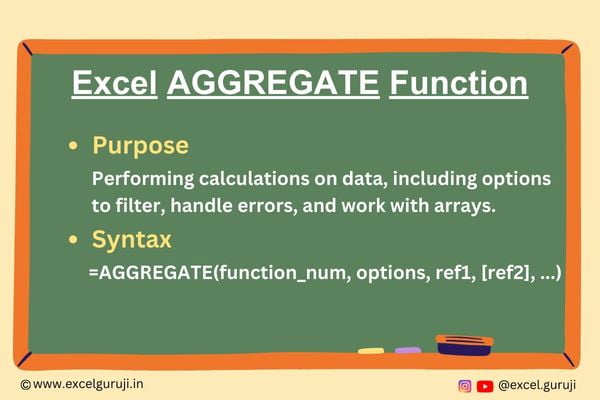
When to Use the Excel AGGREGATE Function in Excel
Excel AGGREGATE function is your go-to choice when you need to perform calculations on a range of values with various options, such as:
Averaging, Summing, or Counting: AGGREGATE can handle tasks like finding the average, sum, or count of values while ignoring hidden rows or error values.
Filtering Data: You can use this function to filter data based on specific criteria and return results that meet your conditions.
Ignoring Errors: AGGREGATE lets you work with data that might contain errors without disrupting your calculations.
Handling Arrays: It is a valuable tool for working with arrays and performing array functions.
What Excel AGGREGATE Function Returns
The Excel AGGREGATE function returns a single result from a specified array or range based on the function number and options you provide. It allows you to perform various calculations like sums, averages, products, standard deviations, and more.
The beauty of AGGREGATE is that it can handle both standard worksheet functions and array functions.
Syntax of Excel AGGREGATE Function
The syntax of the Excel AGGREGATE function is as follows:
=AGGREGATE(function_num, options, ref1, [ref2], …)
Input Arguments
Here are the input arguments for the Excel AGGREGATE function:
● function_num: This argument specifies the function to use for the calculation. It is an integer representing the function type you want to apply (e.g., 1 for AVERAGE, 4 for MAX, 9 for SUM, etc.).
Note : No need to memorize the numeric value; it will be displayed when you enter the formula.
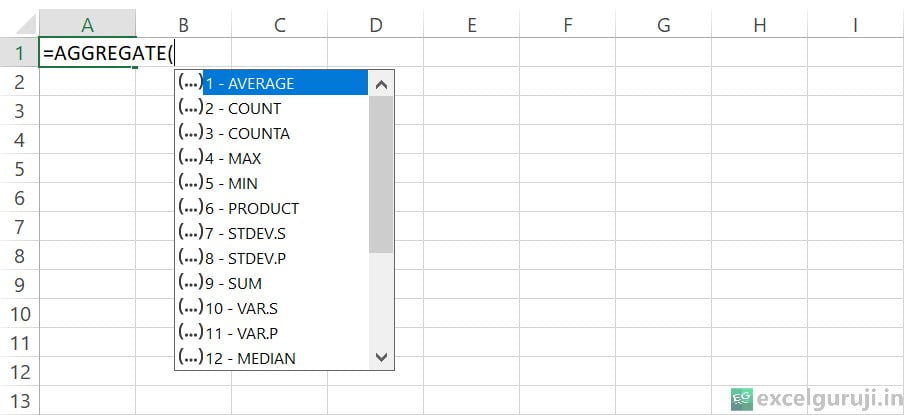
● options: This argument allows you to control how AGGREGATE handles certain conditions like ignoring hidden rows, errors, and nested AGGREGATE functions. You specify this as a number (e.g., 5 to ignore hidden rows, 6 to ignore errors values, and more).
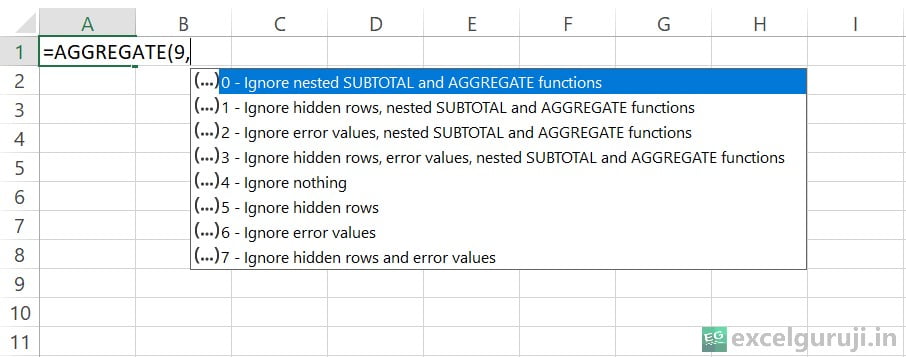
● ref1, [ref2], …: These are references to the ranges or arrays you want to include in your calculation. You can include multiple references, and AGGREGATE will perform the specified function on all of them.
Extra Notes
● If the options argument is omitted, it defaults to 0, which includes nothing special.
● AGGREGATE will generate a #VALUE! error when a second function argument is expected but not supplied.
● You can use the function numbers 1 to 19 to perform various calculations, including AVERAGE, COUNT, MAX, MIN, and more.
● You can nest AGGREGATE functions to create powerful calculations.
Examples of the Excel AGGREGATE Function
Here are a few examples of using the AGGREGATE function in Excel:
Example 1: Calculating the Average of Visible Values
Suppose you have a list of numbers, including some hidden rows. You want to calculate the sum of the visible sales figures. You can use the AGGREGATE function with function_num 9 (SUM) and option 5 (to ignore hidden rows) like this:

In the above example, we observed that when we used the SUM function in cell A7, it included the hidden rows in the calculation. However, when we employed the AGGREGATE function in cell A9, it exclusively summed the visible cells, providing us with the accurate total. In this example, row 3 is hidden.
Example 2: Counting Non-Error Values
Let’s say you have a dataset with some error values (#DIV/0! for instance), and you want to count the non-error values. You can use AGGREGATE with function_num 2 (COUNT) and option 6 (to ignore errors) like this:
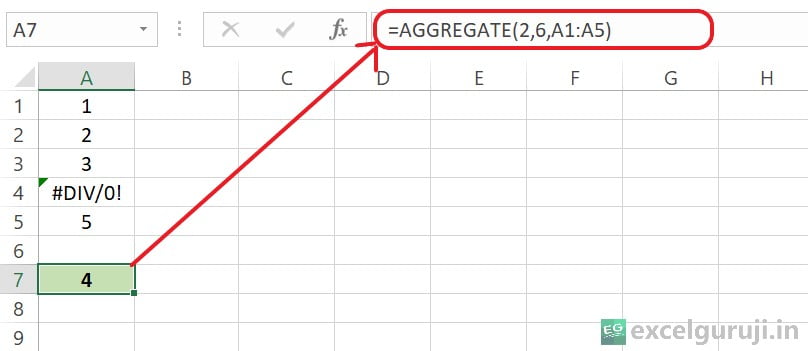
Example 3: Finding the Median of Multiple Ranges
You have two sets of data in different ranges, and you want to find the median of these combined data sets while ignoring errors. You can use AGGREGATE like this:
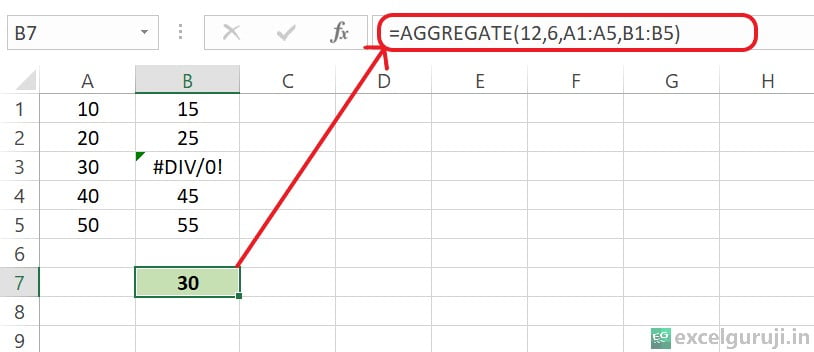
In the example above, we illustrated how the AGGREGATE function enables you to easily calculate the median of multiple data ranges while automatically handling errors, eliminating the need for manual data merging.
Conclusion
In conclusion, the Excel AGGREGATE function is a versatile and powerful tool for handling complex calculations and data analysis tasks.
Whether you need to filter data, perform calculations on error-prone data, or work with arrays, AGGREGATE can streamline your Excel workflows and help you get the results you need.
Just like with any Excel function, practice is key to mastering AGGREGATE. Don’t hesitate to experiment with different function numbers and options to discover its full potential.
Start using the AGGREGATE function today and take your Excel skills to the next level!
Frequently Asked Questions (FAQs)
Q1: Can the AGGREGATE function be used to count error values?
A1: Yes, you can use the AGGREGATE function with function number 7 (COUNT) and option 6 to count non-error values while ignoring errors.
Q2: Can I nest AGGREGATE functions to perform multiple calculations at once?
A2: Absolutely! You can nest AGGREGATE functions to perform complex calculations and data analysis.
Q3: What happens if I use a function number that doesn’t exist with AGGREGATE?
A3: Using an invalid function number will result in an error.
Q4: Can AGGREGATE handle array functions?
A4: Yes, AGGREGATE can handle both standard worksheet functions and array functions, making it a versatile choice for various calculations.
Q5: Are there specific functions for calculating the mode or other statistical measures using AGGREGATE?
A5: Yes, you can use function numbers 11 (MEDIAN) and 13 (MODE.SNGL) for calculating the median and mode, respectively, among others.
Other Related Excel Functions
Mastering Excel SUM Function: Tips and Examples for Efficient Data Calculation (6 Examples)
Mastering Excel SUMIF Function: A Comprehensive Guide for Conditional Summation
Mastering Excel SUMIFS Function: A Comprehensive Guide to Conditional Summing
Join me on Instagram, YouTube and WhatApp Channel for your daily dose of valuable tips and tricks! Catch insightful videos that will enhance your knowledge and skills. Don’t miss out – follow me now!